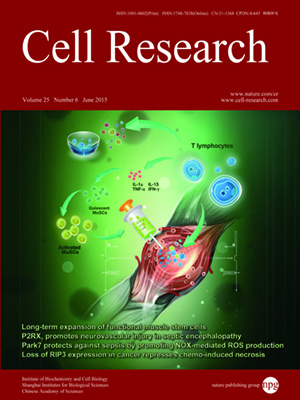
Volume 25, No 6, Jun 2015
ISSN: 1001-0602
EISSN: 1748-7838 2018
impact factor 17.848*
(Clarivate Analytics, 2019)
Volume 25 Issue 6, June 2015: 726-737
ORIGINAL ARTICLES
Structural organization of an intact phycobilisome and its association with photosystem II
Leifu Chang1,2,5,*, Xianwei Liu3,*, Yanbing Li3, Cui-Cui Liu1,2, Fan Yang1,2, Jindong Zhao3,4 and Sen-Fang Sui1,2
1State Key Laboratory of Biomembrane and Membrane Biotechnology, Tsinghua University, Beijing 100084, China
2Center for Structural Biology, School of Life Sciences, Tsinghua University, Beijing 100084, China
3State Key Laboratory of Protein and Plant Genetic Engineering, College of Life Sciences, Peking University, Beijing 100871, China
4Key Laboratory of Phycology of CAS, Institute of Hydrobiology, Chinese Academy of Sciences, Wuhan, Hubei 430072, China
5Current address: MRC Laboratory of Molecular Biology, Cambridge, CB2 0QH, UK
Correspondence: Jindong Zhao(jzhao@pku.edu.cn)
Phycobilisomes (PBSs) are light-harvesting antennae that transfer energy to photosynthetic reaction centers in cyanobacteria and red algae. PBSs are supermolecular complexes composed of phycobiliproteins (PBPs) that bear chromophores for energy absorption and linker proteins. Although the structures of some individual components have been determined using crystallography, the three-dimensional structure of an entire PBS complex, which is critical for understanding the energy transfer mechanism, remains unknown. Here, we report the structures of an intact PBS and a PBS in complex with photosystem II (PSII) from Anabaena sp. strain PCC 7120 using single-particle electron microscopy in combination with biochemical and molecular analyses. In the PBS structure, all PBP trimers and the conserved linker protein domains were unambiguously located, and the global distribution of all chromophores was determined. We provide evidence that ApcE and ApcF are critical for the formation of a protrusion at the bottom of PBS, which plays an important role in mediating PBS interaction with PSII. Our results provide insights into the molecular architecture of an intact PBS at different assembly levels and provide the basis for understanding how the light energy absorbed by PBS is transferred to PSII.
10.1038/cr.2015.59
FULL TEXT | PDF
Browse 2214


